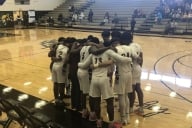You have /5 articles left.
Sign up for a free account or log in.
A day before Northwestern University football players were set to vote on whether to unionize, the 17 college presidents who run Division I of the National Collegiate Athletic Association endorsed a plan that would allow the biggest programs to give athletes unprecedented benefits.
They include scholarship increases up to the full cost of attendance, more insurance coverage for medical expenses, better academic support, and more money for expenses like travel, all of which could give the 65 programs in Bowl Championship Series conferences more freedom to lure the best recruits, and could raise their spending on athletics.
In another significant change, a restructured Division I Board of Directors would include one athlete, an athletics director, a faculty athletic representative and a senior woman administrator, all with voting power.
"The model we sent to the membership today is not a final product," Wake Forest University President Nathan Hatch, who chairs the Division I board and steering committee that wrote the draft, said after Thursday's board meeting in Indianapolis. "Some aspects of the model remain under discussion, and we hope the membership will provide us further input."
The draft now goes to the colleges and conferences for comment and is expected to be put to vote (and passed) at the Division I Board of Directors meeting in August. The additional benefits for athletes have been in the works for years, but the timing is significant and some athletic and NCAA officials have said the rules and governance changes are evidence that unionization is not necessary.
"Regardless of the outcome of this vote and its potential ramifications, the NCAA must act now," University of South Carolina President Harris Pastides, a member of the Division I Executive Committee, wrote in a Chicago Tribune op-ed Sunday. "Admittedly, the wheels of progress have turned too slowly."
Pastides wrote that the athletes' concerns "deserve to be heard," and that the placement of two voting athletes on a new rule-making committee called the Council, comprising 38 on-the-ground practitioners such as commissioners and athletic administrators, was "most important."
But not everyone is convinced that will be enough. The former Northwestern quarterback Kain Colter, who led the unionization movement there, this month questioned just how much influence those athletes will have. "At the end of the day, you need leverage, and that's just what it keeps boiling down to," he said. "Promoting a student-athlete to talk in their meetings is not the same thing."
But two vice chairs of the Division I Student-Athlete Advisory Committee said in an email that they were "grateful" for their role in the new structure.
"Representation on both the Board of Directors and the council with voting rights will further illustrate the value that SAAC and student-athletes have within the NCAA," Kendall Spencer and Dustin Page said. "The support throughout the NCAA membership for the student-athlete voice has been tremendous, and there are no signs that the support will diminish in the future."
Some faculty, though, are not satisfied with the draft governance plan. The Division I Faculty Athletics Representatives board said in a statement Thursday that the board "should go much further in reshaping future collegiate athletics decision-making."
The DI FAR board had advocated for a council with an equal number of FARs and senior athletics administrators, but the current draft reserves 60 percent of the seats for athletic directors alone. If the 60 percent figure is a certainty, the board said, at least use it for all athletic administrators combined to ensure a more balanced voting body.
"Few, if any, collegiate athletics issues are either exclusively athletic or exclusively academic," the board wrote. "The inclusion of an equal number of ADs and FARs would better demonstrate that intercollegiate athletics is a shared partnership between athletics and the greater campus ... and emphasize that the governance structure embraces the overall campus mission to advance the best interests of our student-athletes, not just as athletes, but also as college students."
The council will also have at its disposal three groups focused on academics, championships and legislation. It could create others if necessary.
If the type of rule that the major conferences want to adopt is considered "permissive" legislation -- meaning it allows for the expansion of services, rather than limiting them -- other Division I conferences can adopt the rules as well. All the areas of autonomy endorsed by the board deal with permissive legislation.
The steering committee wrote in its proposal that the members of the five major conferences -- the Atlantic Coast, Big Ten, Big 12, Pacific-12 and Southeastern -- "envision an effective intercollegiate athletics system that fully meets the needs and expectations of student-athletes in the 21st century," they wrote in the draft, first obtained and reported by CBSsports.com. But it notes that the colleges are challenged by "an increasingly litigious environment and confused public sentiment."







